Inspecting Frost-Protected Shallow Foundations (FPSF in IRC R403.3)
by Nick Gromicko and Ben Gromicko
Frost heave caused by ice lenses can wreak havoc on foundations in cold climates, often driving builders to dig below the frost line. Yet, Section R403.3 of the International Residential Code (IRC) outlines a clever alternative: the frost-protected shallow foundation (FPSF). By placing insulation around a heated slab, the building’s own warmth keeps soil from freezing at critical edges. This article explores the mechanics behind FPSFs, outlines essential code requirements, and highlights what inspectors should watch for in the field.
Introduction: A Little Heat Goes a Long Way
A home’s foundation is the essential structural element upon which everything else depends. While there are many foundation designs based on soil type, materials, climate, and house size, an affordable option may be the slab-on-ground foundation. In this design, a single concrete slab—thickened at the edges to support the walls—rests directly on the ground. Below is an illustration of a slab foundation with rigid foam insulation installed to minimize heat loss.

There’s something deeply satisfying about the simplicity of digging a footing below the frost line. It’s clear. It’s time-tested. It’s also often more expensive, labor-intensive, and concrete-heavy.
And yet, in the inspection and building world, many professionals continue to assume that deep excavation is the only way to prevent frost heave — mainly because “that’s how we’ve always done it.” But the International Residential Code (IRC), Section R403.3, gives us more than one option, and one of them is surprisingly clever. Enter the Frost-Protected Shallow Foundation, or FPSF for short.
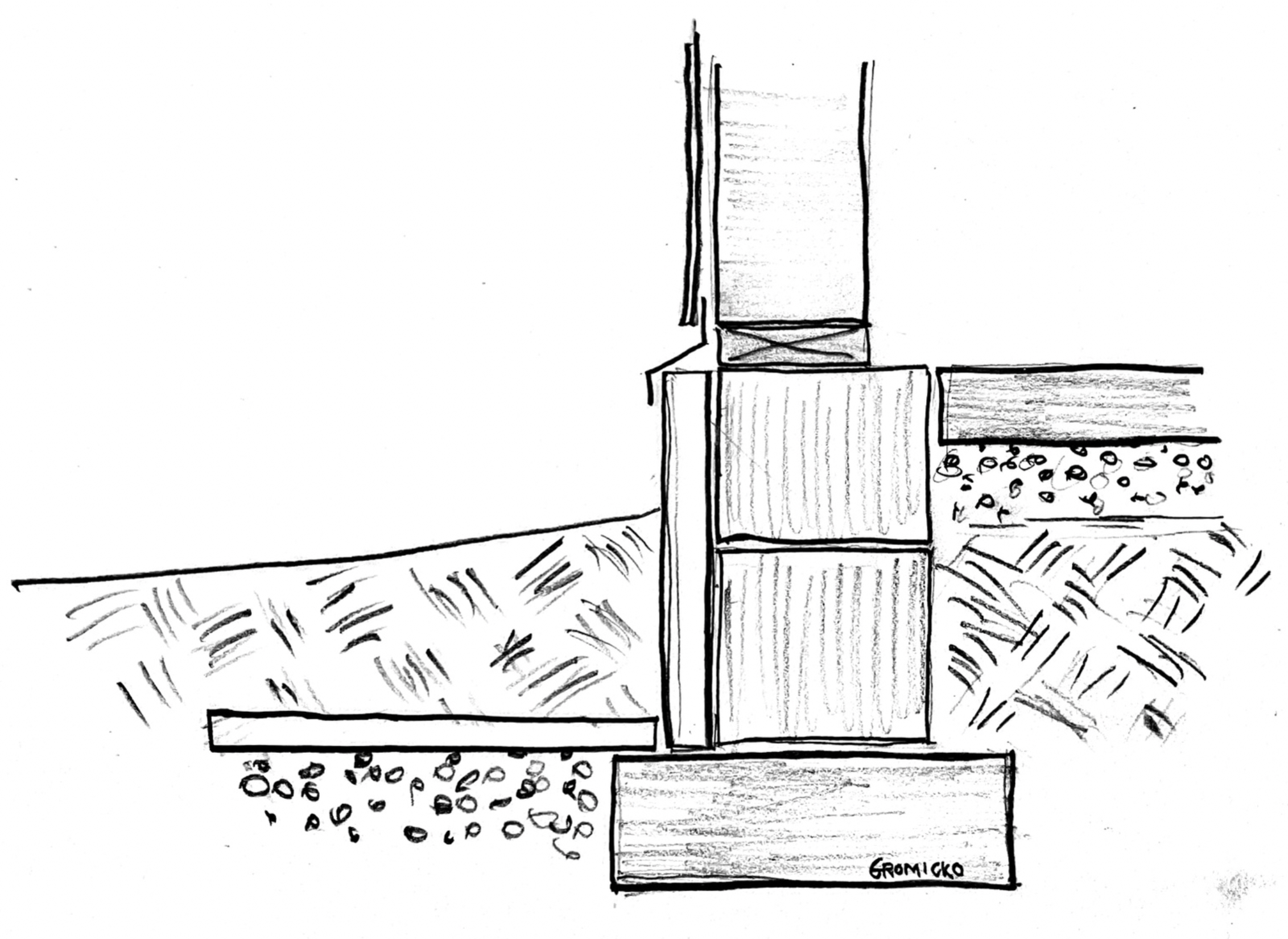
One challenge with slab-on-grade foundations in cold-climate areas is frost heave. Where soil can freeze to considerable depths, moisture in the ground expands when frozen and may lift or crack the slab. A frost-protected shallow foundation (FPSF) addresses this problem by including vertical insulation around the slab perimeter, plus a horizontal “wing” of insulation that extends out several feet, as shown in the illustration above. This insulation barrier helps prevent deep soil freezing at the edges and corners—where the slab is most vulnerable—thereby reducing the likelihood of structural damage.
Rooted in IRC Section R403.3, the FPSF method offers an approved, prescriptive path for keeping foundations safe from frost heave without going deep. Instead of just digging below the freeze zone, it uses rigid foam insulation to hold heat in the soil — keeping it warm enough to stay ice-free all winter long. It’s the thermal equivalent of tucking your foundation in with a warm blanket.

But as with any building system, if you don’t understand how it works — or if the details are skipped or misunderstood — things can go sideways fast. This article is your walkthrough of the code’s intent, the nuts and bolts of FPSF design, and how to spot problems during inspections.
Frost Heave 101: What the Code Is Trying to Prevent
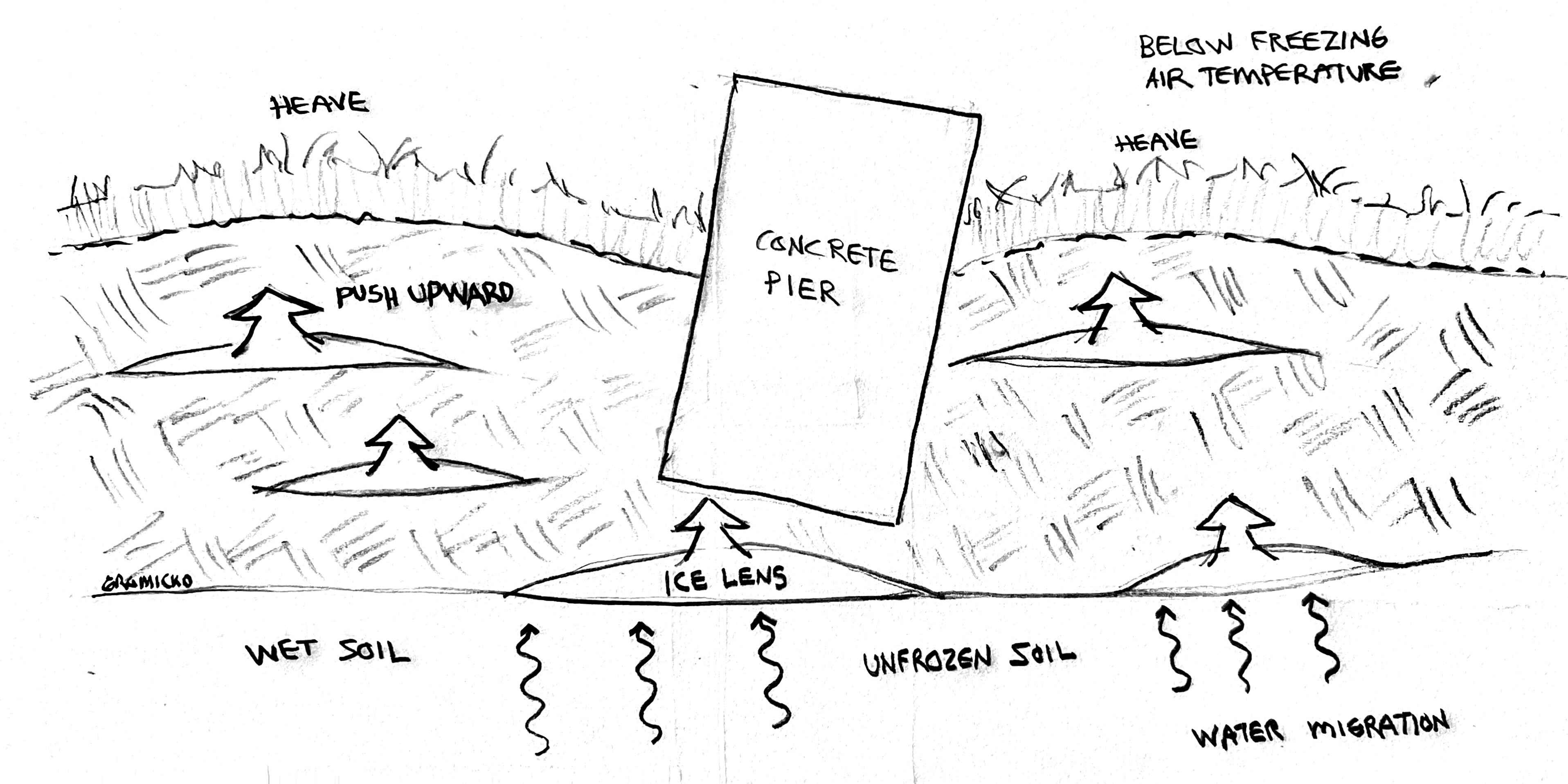
Before we dig into the insulation details, it’s important to understand what we’re fighting against — and what the IRC is trying to accomplish with all this frost protection.
Frost heave happens when three things come together:
- The soil is susceptible to frost (usually fine-grained stuff like silt or loam).
- The soil is wet.
- The temperature drops below freezing.
When these conditions exist, water in the soil starts migrating toward the freezing zone and forms layers of ice called ice lenses.

These grow by drawing water upward and expanding — which, you guessed it, pushes the soil and everything above it up. When the ice eventually melts, the soil slumps back down, usually unevenly. Over time, this can cause structural movement, cracking, and settlement to buildings and other structures like decks and paved sidewalks.
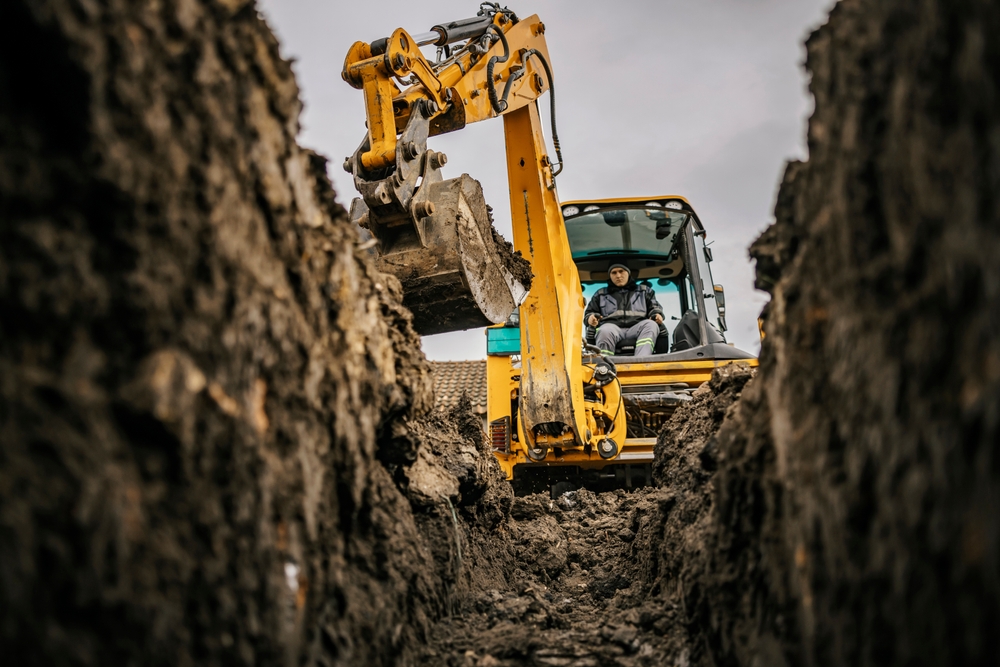
To prevent that, traditional foundations just go deeper than the frost line. It’s a great brute-force solution. But IRC Section R403.1.4.1 clearly says you’ve got options — four, in fact:
- Dig below frost line (the classic)
- Use a frost-protected shallow foundation (R403.3)
- Design per ASCE 32-01 (more flexible, but also more math)
- Rest the foundation directly on solid rock
Remember the wise man who built his house on rock? The IRC includes that same principle as one of four methods to protect against frost heave. And FPSFs are not a loophole. They’re a fully endorsed, code-approved method — when done right.
Note: ASCE 32-01 is a standard published by the American Society of Civil Engineers (ASCE) titled “Design and Construction of Frost-Protected Shallow Foundations.”
What FPSFs Do (and What They Don't)
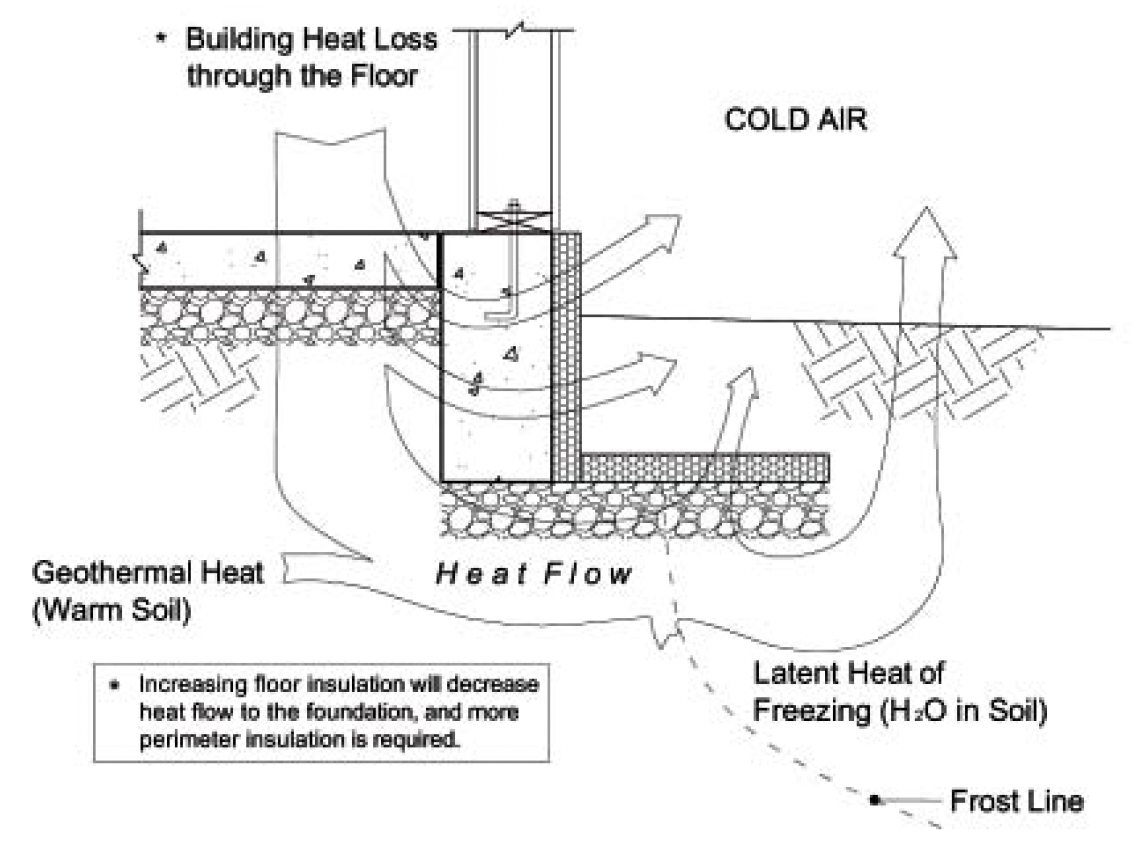
At their core, FPSFs manipulate the temperature of the soil. Instead of avoiding the freeze zone, they use insulation to keep the freeze zone from reaching the foundation in the first place.
But this only works if the building is heated — and that’s not optional. According to IRC R403.3, the building must maintain a monthly mean temperature of at least 64°F (18°C) for the system to work. That’s the temperature baseline the code relies on, because building heat loss is part of the design. In other words, some heat must be allowed to leak into the ground.
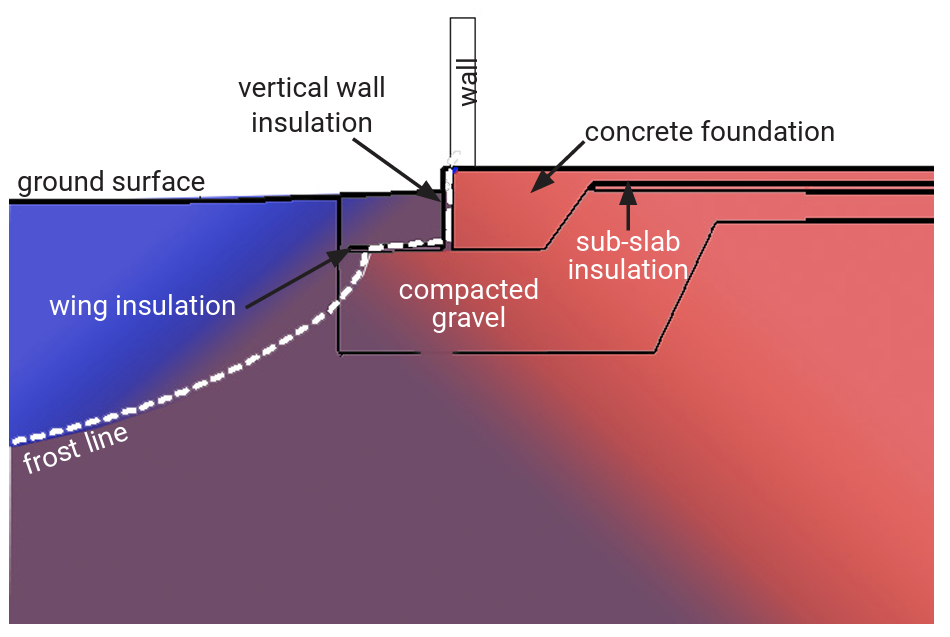
Yes, the FPSF method actually wants some heat loss — but only in the right places, at the right levels. Over-insulate the slab and the system fails. Under-insulate it? Same problem. There’s a sweet spot, and the code spells it out in detail.
A note for the field: If you’re inspecting a new home with an FPSF and they’ve put R-20 insulation under the slab and sealed it like a Yeti cooler, you’ve got a problem. FPSFs need just enough heat to warm the soil — not to keep it hermetically sealed.
Code Focus: IRC Section R403.3 – The FPSF Blueprint
Let’s look closer at what the code actually requires.
IRC Section R403.3 governs frost protection for shallow foundations. It allows footings to be shallower than the frost depth — as little as 12 to 16 inches, depending on climate — if protected by insulation that meets specific values and configurations.
To qualify under this section:
- The structure must be heated (≥ 64°F mean monthly).
- The insulation must meet R-value and depth requirements based on climate.
- The foundation cannot be attached to unheated spaces unless specially designed.
- Insulation materials used below grade must comply with ASTM C578.
The code ties everything to one key climate metric: the Air-Freezing Index (AFI). This is a measure of how cold it gets and for how long — and it determines how much insulation you need.

IRC Table R403.3(1) gives the breakdown:
- Minimum footing depth.
- Required R-values for vertical and horizontal insulation.
- How far the horizontal insulation must extend (especially at corners).
For example, in a cold zone with an AFI of 3,000°F-days:
- Footing depth: 16 inches.
- Vertical insulation: R-7.8.
- Horizontal insulation: R-6.5 at walls, R-8.6 at corners.
- Extension distances: 12 inches at walls, 40 inches at corners.
You can find your local AFI in IRC Table R403.3(2) or NOAA climate data.
Why Heated Buildings Only?
Because without building heat, there’s nothing for the insulation to trap. The entire concept of FPSFs depends on the building leaking just enough heat into the soil to keep it from freezing. If you don’t have heat, you’re going to need a much larger insulation mat and a different design — which is where ASCE 32 comes in.
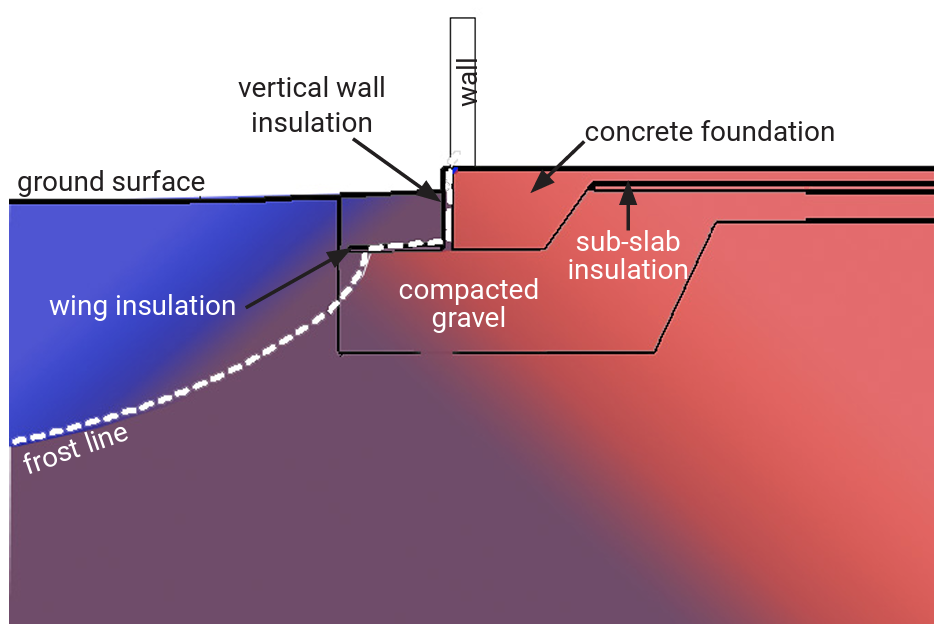
That’s why IRC R403.3 explicitly forbids FPSFs in:
- Unheated garages
- Porches
- Utility rooms
- Crawlspaces or basements without consistent heating
Now, if you’re attaching a garage to an FPSF building, that’s where Section R403.3.1.1 comes in — and we’ll get to that shortly. Spoiler: there’s a lot of foam involved.
FPSF Construction Features: What Makes It Work
Once you’ve accepted that this foundation system depends on heat, the next logical question is: how do we keep that heat where we want it?
The answer lies in the proper installation of vertical and horizontal insulation, along with attention to drainage, soil conditions, and transitions between structures.
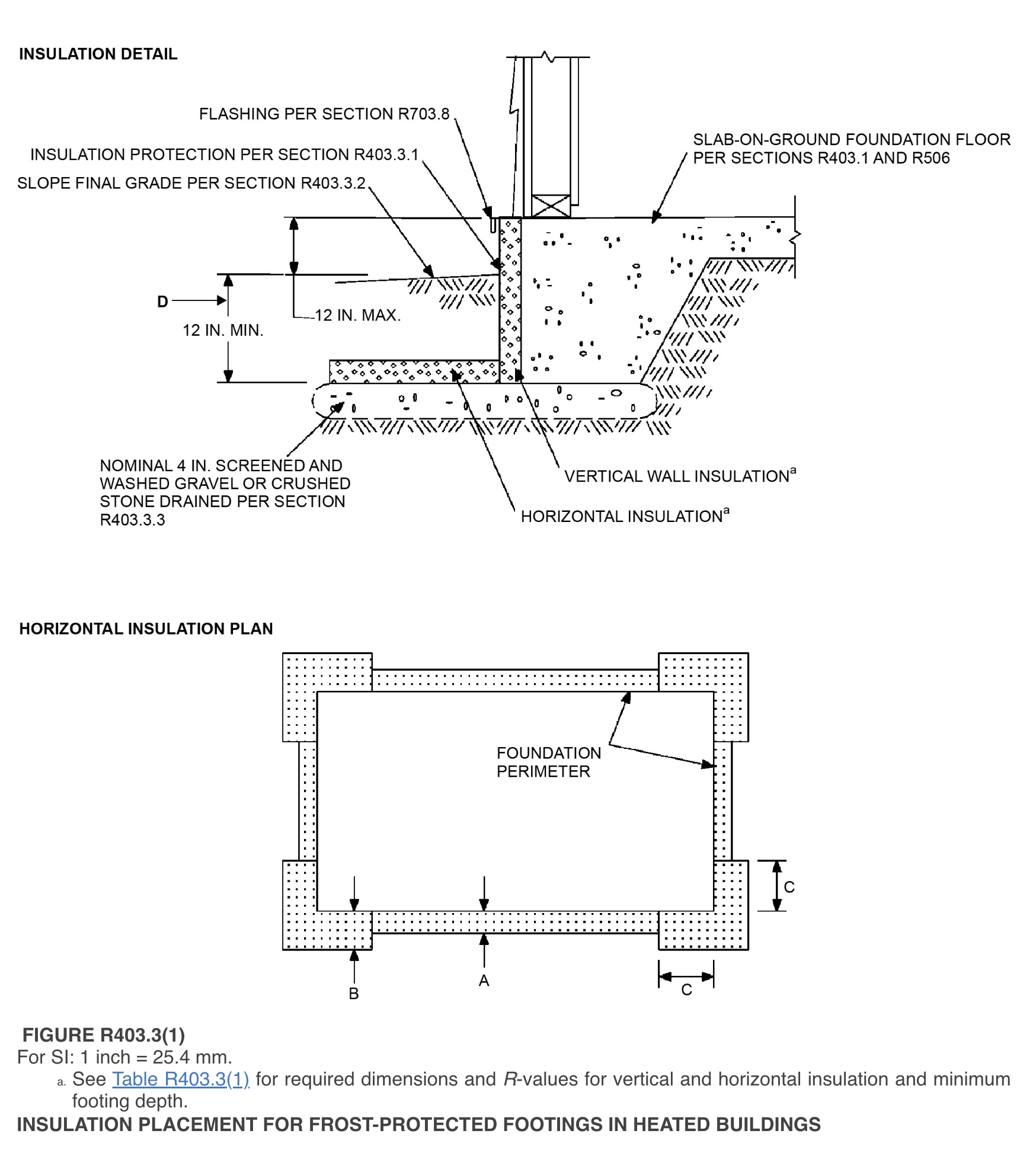
Let’s unpack what the code expects.
Vertical Insulation (The Wall Blanket)
According to IRC R403.3 and ASCE 32 design logic, vertical insulation is required wherever FPSFs are used.
Here’s how it works:
- It runs from the top of the foundation wall to the bottom of the footing, or until it meets horizontal insulation.
- Its job is to limit lateral heat loss — keeping warmth in the soil beneath the structure.
- The R-value requirement is climate-dependent, as listed in IRC Table R403.3(1).
- The insulation must be continuous, with no big gaps or breaks — because heat, like water, loves to find an escape route.
- Vertical and horizontal insulation must be expanded polystyrene insulation or extruded polystyrene insulation.
Inspector Tip: The vertical insulation should be snug, sealed, and protected. If you see exposed pink or blue foam sticking out of the ground with UV damage or chunks missing where the weed whacker's been a little too enthusiastic — that’s a problem.

IRC requires that the above-grade portion of the insulation be protected from physical damage and sunlight. Think cement board, parging, or compatible coatings — anything that keeps the foam from degrading.
Horizontal Insulation (The Thermal Umbrella)
Now for the piece that makes FPSFs truly different: horizontal insulation. This foam lies flat, extending outward from the base of the foundation wall into the soil.
According to the code:
- It should extend 12 to 60 inches, depending on the AFI and whether it’s at a wall or a corner.
- It has to be buried at least 12 inches deep unless protected by concrete, pavers, or another approved cover.
- Corners require more: higher R-values and longer extensions. (Why? Because corners lose heat faster — picture the way your fingers get cold before your palms in winter.)
A quick analogy: Think of the foundation as a campfire and the horizontal insulation as the stones you lay around it to keep the heat in. No stones = lost heat = frozen ground = heaving structure.
What if the insulation is too shallow, unprotected, or just... missing?
Then your FPSF isn’t really frost-protected — it’s just a shallow foundation waiting for a problem.
Gravel Base and Soil Considerations

Where the soil beneath the horizontal insulation and footing does not have very good drainage characteristics (Group I, sand or gravel), IRC R403.3.3 requires a 4-inch layer of washed gravel or crushed stone in accordance with Figure R403.3(1). Why? Because gravel:
- Drains well
- Doesn’t hold water
- Reduces frost heave risk from capillary action
But here’s where it gets tricky. If the soil below the gravel isn’t Group I, the gravel has to drain to daylight or into a storm system. This is to keep water from saturating the soil beneath the foam and footing.
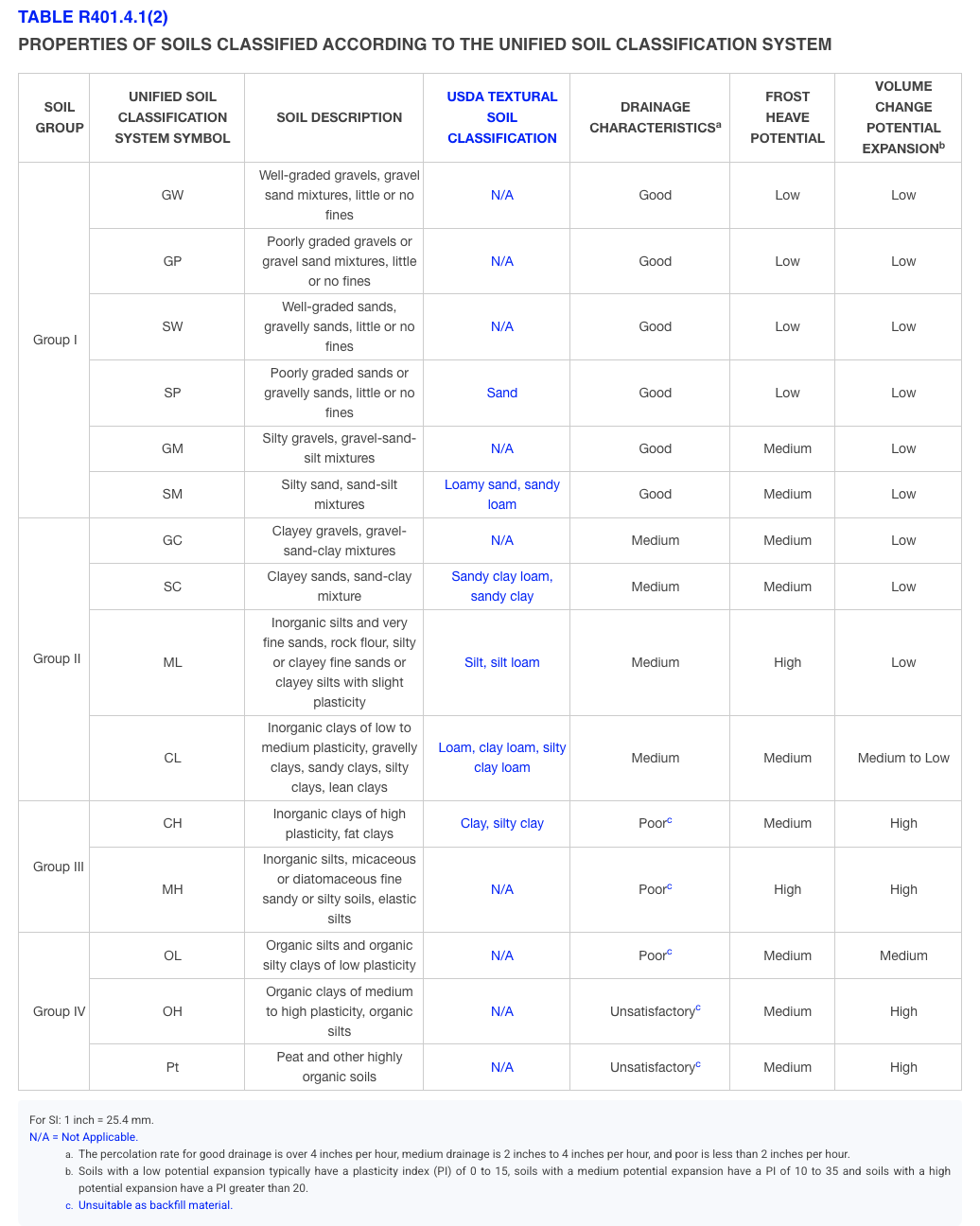
Code Reference: Table R401.4.1(2) defines Group I soils. If you're standing in silty clay, don't assume water will politely leave — it won’t.
Inspectors should confirm:
- Presence of proper base material
- Adequate drainage pathways
- Final grade slopes away from the foundation (IRC R401.3 requires 6" drop over 10 feet) as illustrated below.

Connecting FPSFs to Other Foundations: Where Mistakes Happen
This is one of the most misunderstood aspects of FPSF construction — and it’s where even experienced crews sometimes get tripped up. Let’s clear it up with help from IRC R403.3.1 through R403.3.1.2.
Scenario 1: FPSF Attached to an Unheated Slab (R403.3.1.1)
Let’s say we’ve got a heated home on an FPSF slab, and someone wants to attach an unheated garage on a shallow slab.
You might think, “No big deal, it’s just a garage.” But here’s the problem: that unheated space can act like a frost tunnel, letting cold soil encroach under the heated home.
To prevent this, the IRC requires:
- Vertical insulation between the two slabs
- Horizontal insulation that runs under the unheated slab and through any shared wall
- If insulation passes under a wall, it must either:
- Be strong enough to support the building, or
- Loads must be diverted around it using beams, cantilevers, or similar.
Think of it as trenching an insulation moat under the garage — keeping the cold away from the warm zone.
Scenario 2: FPSF Attached to a Heated Slab (R403.3.1.2)
Good news: If both structures are heated, you’re allowed a little more flexibility.
In this case:
- You don’t need insulation between the two structures
- But you do need horizontal insulation to extend along the adjoining structure's perimeter
If the two structures meet at an inside corner, the vertical insulation along that portion of the wall isn’t required. The intersecting warmth from both buildings protects the soil.
Quick Reminder: “Heated” means the space maintains a monthly mean temperature of 64°F or more. If it’s heated only when someone remembers to turn the thermostat up on weekends — it’s not heated per code.
One Last Thing: Termites and Foam Don’t Mix (Section R305.4)

In regions where the probability of termite infestation is “very heavy” (as determined by IRC Figure R305.4), foam plastics (including extruded and expanded polystyrene and polyisocyanurate) are not permitted on:
- The exterior face of foundation walls (both interior and exterior) located below grade.
- Under foundation walls or slab foundations that sit below grade.
This code provision exists because foam insulation can obscure termite entry paths and make termite infestation more difficult to detect. By restricting below-grade installation in high-termite regions, the IRC aims to prevent concealed termites from bypassing typical inspection barriers.
Clearance Above Grade
When foam plastic is installed above grade, it must be separated from the exposed earth by no less than 6 inches (152 mm). This clearance prevents direct soil contact, which reduces the chances of termites bypassing visual inspections or protective barriers.
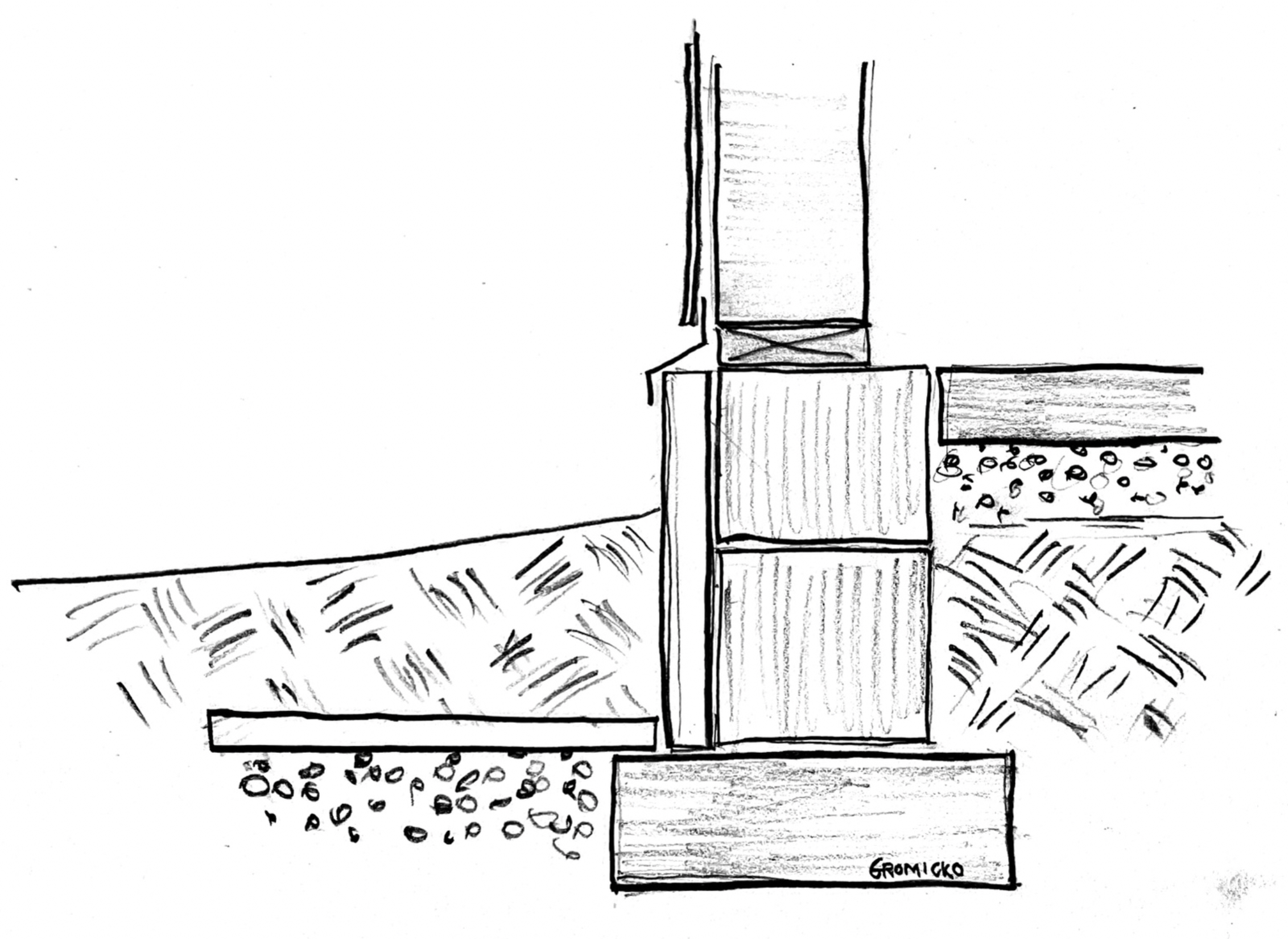
Exceptions
There are three exceptions to this rule:
- Noncombustible or Treated Structural Components. Buildings where all walls, floors, ceilings, and roofs are constructed entirely of noncombustible materials or pressure-preservative-treated wood are exempt. These materials are inherently more resistant to termite damage, mitigating the risk associated with foam insulation.
- Additional Approved Termite Protection. Foam plastics may still be used if, in addition to the requirements in Section R305.1, an approved method of termite protection is employed. This might include enhanced physical or chemical barriers designed specifically for subterranean termites.
- Interior Side of Basement Walls. Foam plastics can be installed on the interior side of basement walls even in high-termite zones. Interior insulation typically allows for more thorough inspection of critical exterior points of termite entry.
Subterranean Termite Control Methods (Section R305.1)

In regions identified by Table R301.2 of the IRC as “subject to damage from termites,” one or a combination of the following six strategies must be used to protect structures:
- Chemical Termiticide Treatment (Section R305.2). A chemical application to the soil around and under a foundation creates a barrier lethal or repellent to termites, preventing them from entering the structure.
- Termite-Baiting System. When installed and maintained according to the product’s label, these systems intercept and eliminate termite colonies by drawing worker termites to bait stations around the property.
- Pressure-Preservative-Treated Wood (Section R304.1). Wood treated with chemical preservatives resists termite damage. Properly labeled pressure-treated lumber offers a level of defense against infestation.
- Naturally Durable Termite-Resistant Wood. Certain species (e.g., redwood and cedar) possess natural termite resistance. Though not foolproof, they can be effective in conjunction with other protective measures.
- Physical Barriers (Section R305.3). Physical barriers, such as fine stainless-steel mesh or graded stone particles, can block termite entry points. Used together with approved building practices (see Section R304.1 for locations), they form a layer that subterranean termites cannot penetrate or navigate around.
- Cold-Formed Steel Framing. Cold-formed steel studs and structural components in compliance with Sections R505.2.1 and R603.2.1 are naturally immune to termite damage, although additional precautions for other building elements (like trim and sheathing) may still be necessary.
Inspection Tips and Best Practices
Verify Proper Clearance. When foam insulation is installed above grade, ensure there is a 6-inch clearance to the soil. Anything less can create unmonitored paths for termites.
Examine Transition Areas. At the junction of below-grade and above-grade insulation, carefully check for signs of termite tubes or burrowing. These areas are prone to hidden pathways.
Look for Approved Treatment Methods. When foam is present below grade (under an exception), confirm that additional termite control methods—like chemical barriers—are documented and verifiable.
Check for Material Labels. If wood is used as part of the exception, ensure that it is labeled as pressure-preservative-treated or confirmed to be a naturally durable species.
Consider Long-Term Maintenance. Termite-control measures can degrade over time. Chemical barriers may dissipate, and bait stations need consistent servicing. Communicate to homeowners or property managers the importance of ongoing monitoring.
Inspecting FPSFs: What to Look For (and What to Question)
By now, it should be clear that a frost-protected shallow foundation is not just a regular slab with some foam tacked on. It’s a carefully calculated system that relies on:
- Climate-specific design (based on the AFI)
- A heated building (≥ 64°F mean monthly temperature)
- Strategic use of vertical and horizontal insulation
- Adequate soil drainage and material selection
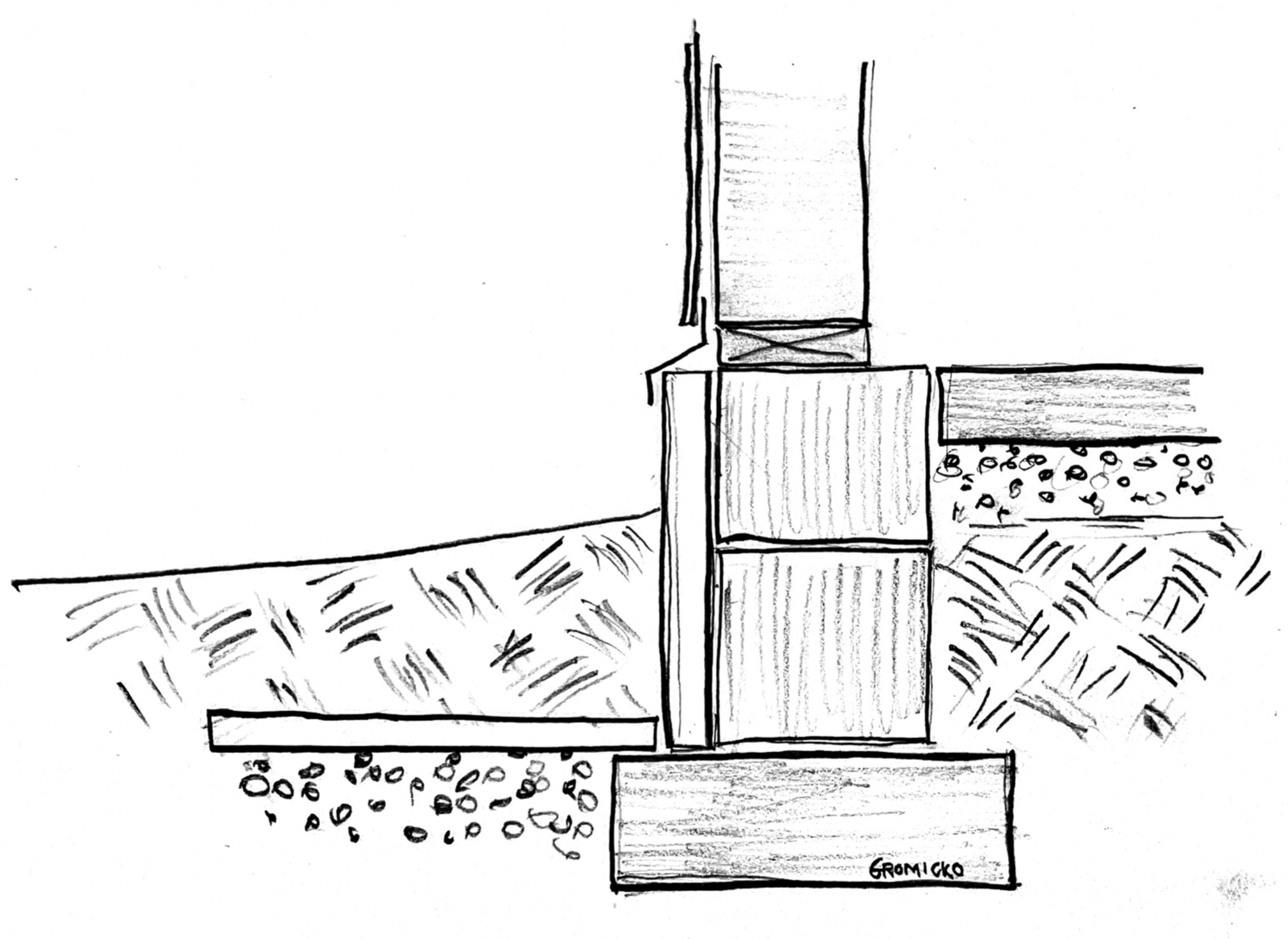
So when you’re inspecting an FPSF, whether it’s a new build or part of a remodel, your job is to verify that this system has been designed and installed in line with IRC R403.3 — and that no shortcuts were taken.
Let’s walk through the critical inspection points.
Is the Building Actually Heated? (R403.3, baseline requirement)
First and foremost, the code only allows FPSFs under heated structures. The temperature must be maintained at 64°F or higher on a monthly average.
This means:
- No seasonal heating (e.g., hunting cabins)
- No attached porches unless they’re insulated and conditioned
- No garages, unless they meet the heat requirement and insulation is continuous
What to check:
- Heating system installed and operational
- Thermostat present and reasonably programmed
- The unheated garage or carport isn’t sharing the same foundation system without proper isolation
Check the Insulation — Vertical and Horizontal (R403.3.1 and Table R403.3(1))
Once you’ve confirmed the building qualifies, next up is the insulation layout. IRC Table R403.3(1) tells you exactly what to expect based on the local Air-Freezing Index (AFI). Look up your jurisdiction’s AFI in IRC Table R403.3(2) or a local climate map.
Verify the following:
- Vertical insulation runs full height from top of foundation wall to the bottom of the slab or footing
- Horizontal insulation extends the correct distance (Dimension A), with increased width and R-value at corners
- R-values match the table — some contractors still think any foam board will do
Watch for substitutions. Not all rigid foam has the same compressive strength or long-term R-value. Insulation must comply with ASTM C578, and the builder should derate values for long-term soil contact if not using XPS.
Are Corners Properly Insulated?
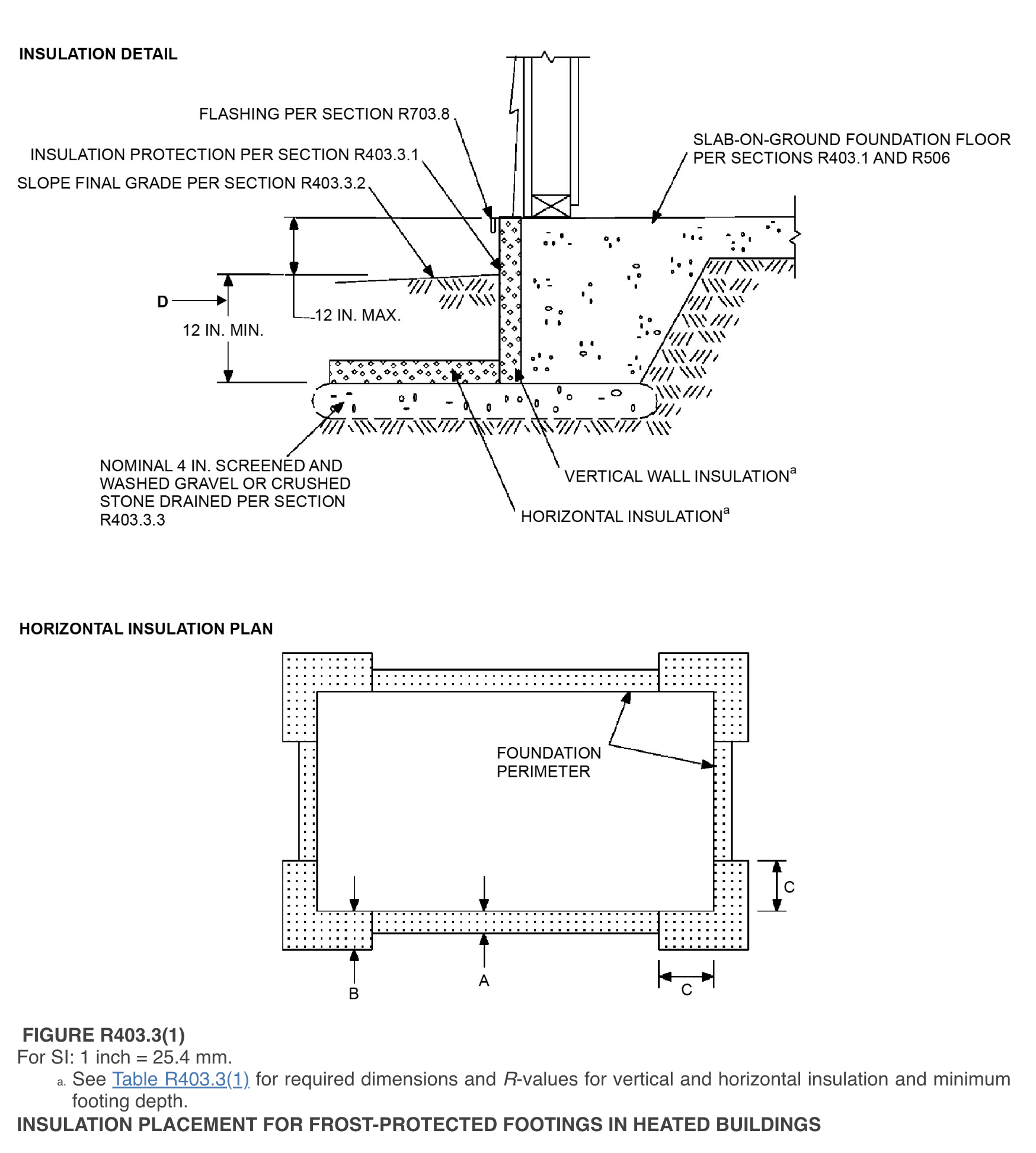
Corners get cold faster — it’s just physics. The code requires longer and thicker horizontal insulation at corners, because these areas are the most vulnerable to frost penetration.
Red flags:
- Same insulation used everywhere (no increased corner coverage)
- Gaps or missing foam at foundation corners
- Foam joints that aren’t taped or sealed
Check for Drainage and Soil Prep (R403.3.2 and R401.3)
FPSFs don’t just manage temperature — they manage moisture. Without proper drainage, the foundation could still experience heaving.
The IRC requires:
- 4" minimum washed gravel or crushed stone beneath the footing
- Drainage to daylight or approved system for soils other than Group I (see IRC Table Table R401.4.1(2)
- Grade slope of 6” in 10 feet away from the foundation
On site:
- Confirm that the right gravel layer exists
- Look for signs of pooling, blocked drains, or improper grading
Look at Transitions to Other Foundations (R403.3.1.1 and R403.3.1.2)
The most common FPSF failure point isn’t the insulation or even the soil — it’s when the system tries to connect to another structure, especially one that isn’t heated.
Remember:
- Unheated slabs (garages, porches) must be isolated with insulation running between and under the slabs, through any foundation walls
- Heated structures that share a foundation must still have horizontal insulation extending along the perimeter
If insulation passes through a foundation wall (e.g., under a shared wall), it either needs the load-bearing capacity to support the structure, or the structure must be designed to transfer loads off the foam.
Is the Foam Protected from Damage? (R403.3.2 and R403.3.4)
Foam board is tough, but not invincible. And it doesn’t like UV rays, lawn equipment, or termites — especially not termites.
The IRC requires:
- Protection for any exposed foam (cementitious board, treated plywood, parging, etc.)
- Termite protection for below-grade insulation in “very heavy” termite zones (see R318.4)
In the field:
- Look for exposed, dented, chewed-up, or weathered foam
- Ask about the termite control method used — if the builder looks at you like you just made that up, dig deeper
Real-World Inspection Scenario
- Location: Central Minnesota
- Project: Heated slab-on-grade home with attached garage
- Design: FPSF used under the main house
- Issue: Garage is unheated and slab-on-grade, no horizontal insulation beneath it
What You Find:
- Vertical insulation around house slab is installed properly. Good.
- No thermal break between house and garage. Bad.
- No horizontal foam under garage slab. Bad.
Code Violation:
This violates R403.3.1.1. The garage is an unheated space sharing a foundation system with an FPSF — without the required insulation detail.
Consequences:
- Frost could enter through the garage slab and undermine the heated structure’s foundation
- The entire FPSF system could be compromised
When reviewing an FPSF:
- Start with the code: IRC R403.3
- Confirm it’s being used only under heated structures
- Check that insulation matches the AFI-based requirements from the tables
- Watch for corner detailing, drainage, and unheated attachments
- Inspect for foam protection and termite compliance
Like most things in building science, FPSFs aren’t “hard” — but they require attention to detail. And once you know what you’re looking for, you can spot a good one — or a risky one — from a mile away.
So, grab the codebook, walk the perimeter, peek under that slab edge, and when you find something that doesn’t quite add up, ask the right questions. That’s what good inspectors do — with or without a little frost on the ground.
Frost Heave Caused by Ice Lens
Here’s a little more info about ice lens and frost heave.
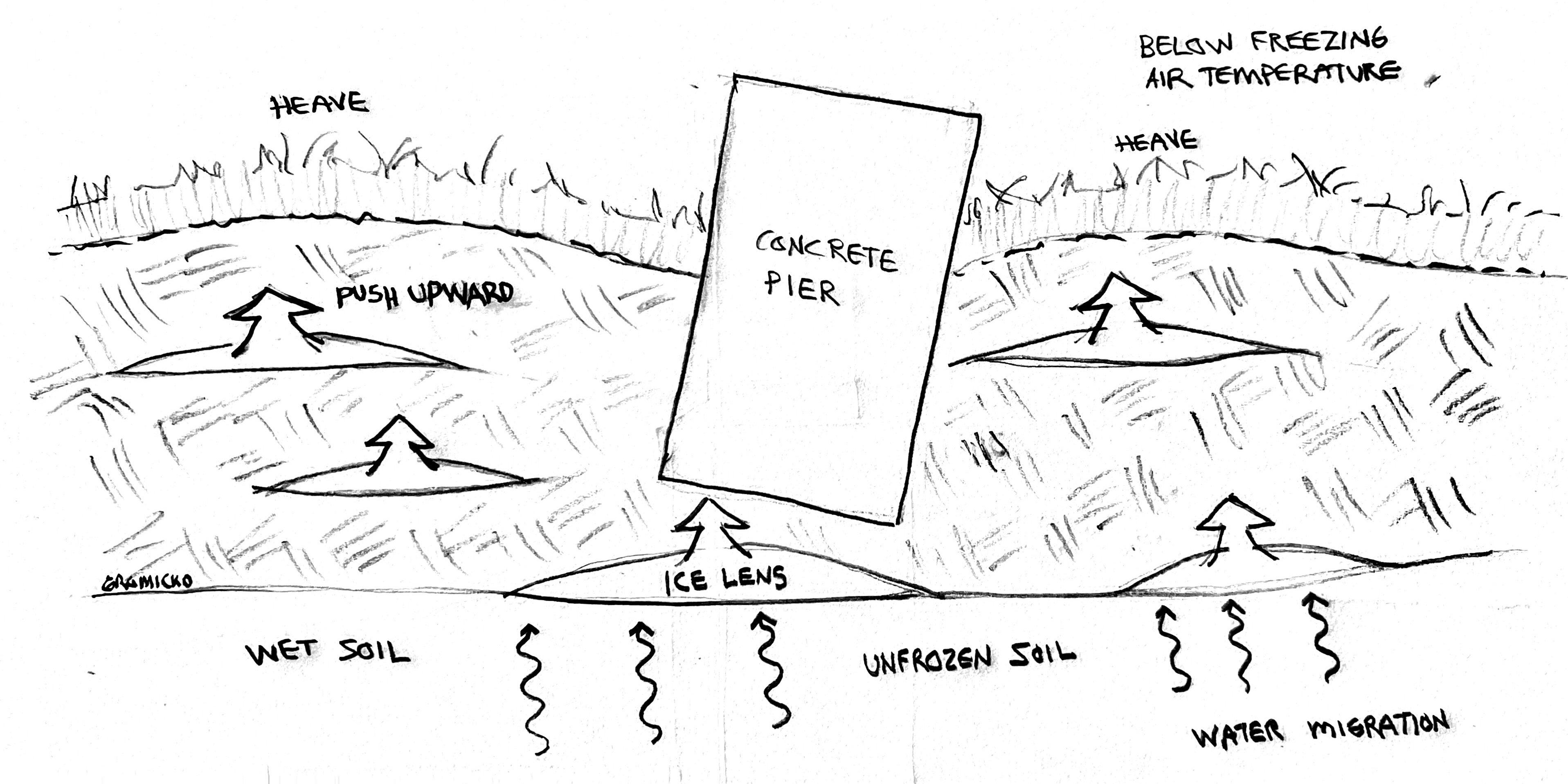
Definition of Ice Lenses
An ice lens is a layer or band of pure ice that forms within freezing, moist soil. These lenses can grow and stack in stratified layers, causing the ground above to heave or lift.
Conditions That Promote Ice Lens Formation
Ice lenses form when the following three conditions are met:
- Freezing Temperatures at the Surface. There must be a consistent downward-moving freezing front, usually during cold seasons when the air temperature is below 32°F (0°C). The soil doesn’t freeze all at once; rather, a freeze line slowly moves downward through the soil.
- Availability of Water. Unfrozen groundwater or soil moisture must be present beneath the freezing zone. This moisture supplies the freezing front with liquid water, which then migrates upward through capillary action and freezes.
- Frost-Susceptible Soil. Soils that are fine-grained, such as silts and clays, are most susceptible. These soils have small pore spaces that support capillary water movement, enabling water to rise toward the freezing front.
Mechanism of Ice Lens Growth

The formation of ice lenses is based on thermodynamics and capillarity:
- As the upper layer of soil begins to freeze, it extracts latent heat from the surrounding unfrozen water.
- This initiates a temperature gradient, drawing liquid water from the deeper, unfrozen layers upward.
- The migrating water freezes when it reaches the colder zone, forming a distinct lens of ice.
- As long as the freezing continues and unfrozen water remains available, the ice lens grows thicker.
This process can repeat itself, forming multiple stacked lenses and pushing the soil surface upward. This is the essence of frost heave.
Why Ice Lenses Matter in Construction and Inspection
For home inspectors and builders, understanding ice lenses is critical because:
- Frost heave can damage foundations, especially shallow footings, walkways, driveways, and slabs not properly protected against freezing.
- Moisture control and soil selection are essential during site preparation.
- Proper use of non-frost-susceptible fill, insulation, or drainage systems can help prevent the conditions that lead to ice lens formation.
Ice lenses are based upon the principle that when certain soils are exposed to freezing temperatures and have access to liquid water, capillary action draws water toward the freezing front, where it freezes and accumulates into layered ice bands. These ice lenses can expand and lift the soil, leading to structural damage known as frost heave. Understanding the mechanics behind ice lens formation is crucial for proper building design, especially in cold climates.
Ice lens formation—and the associated problem of frost heave—is a serious concern for building officials, engineers, and inspectors, primarily in cold climates, where soils freeze seasonally and remain frozen for extended periods. The phenomenon is not uniform globally; it’s region-specific, depending on climate, soil type, and groundwater availability.
Summary
Frost-protected shallow foundations (FPSFs) present a well-established, code-approved alternative to deep footings in cold climates. By harnessing the building’s own heat and maintaining precise insulation strategies—both vertical and horizontal—this method effectively wards off frost heave. Strict adherence to IRC Section R403.3 ensures that FPSFs remain viable and safe, provided the building is heated to the required baseline temperature. The real challenge lies in paying close attention to insulation details at corners, ensuring proper drainage for frost-susceptible soils, and protecting foam insulation from damage and termite risks. Done correctly, an FPSF can deliver both structural reliability and cost savings, not to mention energy efficiency gains. Ultimately, understanding how ice lenses form and how each component of the system works in tandem empowers inspectors, builders, and homeowners alike to trust this innovative foundation design.
Further Reading
To deepen your understanding of foundation systems and building code requirements, consider exploring these related articles:
- From Foundation to Roof: Understanding All Types of Code Inspections (IRC R109). Learn the different types of inspections conducted that are listed and described in the International Residential Code (IRC).
- Inspecting Foundation Fortitude: Cracking the Code for a Solid Home (IRC R401-R408). Learn how building codes ensure structural integrity of foundation systems.
- Foundation Fundamentals: Inspecting Load Paths and Water Paths (IRC R401.2 & R401.3). Learn how foundations manage structural loads and water management requirements.
- Inspecting Footings: The Unsung Heroes Beneath a House (IRC R403). Learn the critical role of properly designed and installed footings.
- Steel Bones: Inspecting the Critical Role of Rebar in Foundation Strength (IRC R403.1-R403.1.6). Learn how rebar in concrete footings functions as a skeletal framework of steel, providing tensile strength and structural integrity to the foundation.
- Securing the Perimeter: Inspecting Foundation Anchor Bolts and Sill Plate Protocols (IRC R403.1.6). Learn about the connection between a building's frame and its foundation.
- Inspecting Frost-Protected Shallow Foundations (FPSF in IRC R403.3). Learn about frost heave, ice lenses, and frost-protected shallow foundations.
- Inspecting Foundation Drainage: Essential Guideline for Below-Grade Spaces (IRC R405). Learn how to inspect subsurface drainage systems that collect and redirect groundwater away from the foundation.
These resources provide information will give home inspectors, building code inspectors, and contractors a well-rounded understanding of how a home is built safe, functional, and healthy.
More Information
- Free, Online ICC-Approved CEU Courses
- 2023 Florida Residential Building Code Course
- Property Maintenance and Housing Code Inspector Course
- Advanced Residential Code Inspection Practice Questions
- 2021 International Residential Code® (IRC®) Exam Study Course
To learn more about homes, inspections, and building standards, visit www.nachi.org/education.
To become a certified home inspector, visit www.nachi.org/certifications.

Join the International Association of Professional Contractors.
